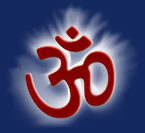Paramahansa Yogananda
Best Quotes
AUM (OM)
The Hindu Bible (Bhagavad Gita), the Christian Bible, and the greatest book on yoga (Patanjali's Yoga Sutras) unanimously declare the Cosmic Sound to be the outward manifestation or witness of the Lord in creation. Krishna, Jesus, and Patanjali all taught that man must receive the Holy Ghost (the Comforter) in order to reach the Christ Intelligence within it and God the Father existing beyond it (beyond Aum or vibratory creation). (bg p.617)
![]()
Aum is the most sacred symbol that can be used to know God. The vibration of Aum contains all the concepts of Him and all His manifestations. No other mantra or symbol gives greater calmness and divine attunement of the mind to God. Chanting this sacred Name leads to perception of the Infinite.
![]()
Kriya Yoga is mentioned twice by the ancient sage Patanjali, foremost exponent of yoga, who wrote: "Kriya Yoga consists of body discipline, mental control, and meditating on Aum." Patanjali speaks of God as the actual Cosmic Sound of Aum heard in meditation. [Yoga Sutra I:27] Aum is the Creative Word, the sound of the Vibratory Motor. Even the yoga-beginner soon inwardly hears the wondrous sound of Aum. Receiving this blissful spiritual encouragement, the devotee becomes assured that he is in actual touch with divine realms. (aoy p.237)
![]()
God manifests in creation as the Cosmic Vibration, which expresses itself as Cosmic Sound and Cosmic Light. The Cosmic Sound or Aum is the synthesis of all the sounds of the highly vibrating life forces (lifetrons), electrons, protons, and atoms. By listening to Aum, the yogi becomes a true brahmachari or one who is attuned to Brahman. By deep concentration the devotee can hear Aum at any time and in any place. (bg p.614)
![]()
The cosmic Aum sound is the combined vibration of the three phases of Nature:
creation,
preservation, and
dissolution
operative in the physical, astral, and causal universes. The vocal chanting of Aum should be intoned first in a high pitch, representing creation; then in a lower pitch, representing preservation; then in a still lower tone that gradually fades away, representing dissolution. The chanting should be first loudly, then softly, and then gently until it is inaudible, or mental only.
The real, or superconscious, chanting of Aum, however, consists not in an imitative vocalization of Aum, but in actually hearing the Holy Sound. All physical sounds are transmitted through the medium of ether; but although Aum vibrates in the ether—which is the background of all manifested activity—the Aum sound vibrates independently of the etheric medium. It is thus referred to as anahata-nada (a sound produced otherwise than by being beaten or struck—that is, without detonation) because it manifests in the yogi's intuition without striking his eardrum through the medium of ether—as with physical sounds. Aum, being a spiritual vibration, is not heard physically, but felt spiritually. (bg p.615)
![]()
An avowed man of renunciation, fearlessly, with serene heart and controlled mind, can think of God as his Supreme Goal. But in a higher state the yogi becomes one with God; having found the Lord through Aum and Its pratipadya (the cosmic bliss that follows after the perception of the Cosmic Sound or Holy Ghost), he achieves complete liberation. (bg p.615)
![]()
 Aum is the best symbol for those who want to worship a personal God. It is a better symbol than images, such as those of Kali, Krishna, and others; because in worshipping God as an image, the mind limits the Infinite to that form. It becomes difficult for the sadhaka ("practitioner", meditator) to think of God beyond that 'ishta', when in fact God is Spirit. While meditating on Aum, the mind expands with the omnipresence of that vibration, and the Spirit-nature of Brahman inherent therein is realized as Sat-chit-ananda — ever-existing, ever-conscious, ever-new Bliss.
Aum is the best symbol for those who want to worship a personal God. It is a better symbol than images, such as those of Kali, Krishna, and others; because in worshipping God as an image, the mind limits the Infinite to that form. It becomes difficult for the sadhaka ("practitioner", meditator) to think of God beyond that 'ishta', when in fact God is Spirit. While meditating on Aum, the mind expands with the omnipresence of that vibration, and the Spirit-nature of Brahman inherent therein is realized as Sat-chit-ananda — ever-existing, ever-conscious, ever-new Bliss.
![]()